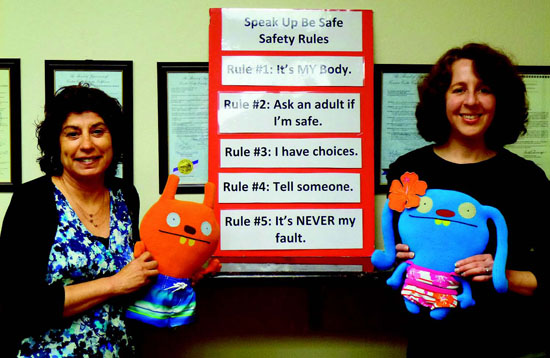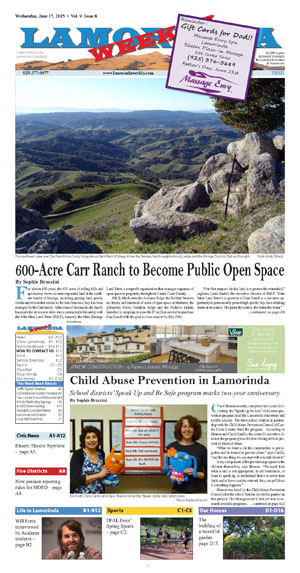|
|
Published June 17th, 2015
|
Child Abuse Prevention in Lamorinda
|
| School districts' Speak Up and Be Safe program marks two-year anniversary |
| By Sophie Braccini |
 |
| From left: Carol Carillo and Carol Shenon show the "Speak Up Be Safe" safety rules. Photo Sophie Braccini |
Carol Shenon recently completed two years facilitating the "Speak Up Be Safe" child abuse prevention program at all the Lamorinda elementary and middle schools. The three school districts in partnership with the Child Abuse Prevention Council of Contra Costa County fund the program. According to Shenon and Carol Carrillo, the council's executive director, the program gives children lifelong skills to prevent all kinds of abuse.
 "What we want is for the communities to get together and be trained to prevent abuse," says Carillo, "and the one thing we can start with is to talk about it."
"What we want is for the communities to get together and be trained to prevent abuse," says Carillo, "and the one thing we can start with is to talk about it."
 A key component of the prevention program is the children themselves, says Shenon. "We teach kids what is and is not appropriate, to set boundaries, to learn to speak up, to understand that it is never their fault, and to have a safety network they can pull from if something happens."
A key component of the prevention program is the children themselves, says Shenon. "We teach kids what is and is not appropriate, to set boundaries, to learn to speak up, to understand that it is never their fault, and to have a safety network they can pull from if something happens."
 Shenon was hired by the Child Abuse Prevention Council after the school districts decided to partner on this project. The Moraga mom's first job was to research available programs. "We chose the program Speak Up Be Safe that had been developed by a team of researchers at Arizona State University," she says. The school districts also asked Shenon to add a sexual harassment component to it, which she did.
Shenon was hired by the Child Abuse Prevention Council after the school districts decided to partner on this project. The Moraga mom's first job was to research available programs. "We chose the program Speak Up Be Safe that had been developed by a team of researchers at Arizona State University," she says. The school districts also asked Shenon to add a sexual harassment component to it, which she did.
 Shenon visits all first-, third-, fifth-, and sixth-graders twice a year. "The lessons are age appropriate, they get a little longer, and the content is built upon by adding more information as the kids gets older," she says.
Shenon visits all first-, third-, fifth-, and sixth-graders twice a year. "The lessons are age appropriate, they get a little longer, and the content is built upon by adding more information as the kids gets older," she says.
 Shenon starts by talking to the students about private body parts. "Those are the parts covered by a swim suit," she says, "and those parts are called private because they should not ever be touched or seen by others." She does explain that a doctor, in the presence of parents, could check private parts. "What I really try to get the first-graders to really understand is that show or touch of a private part is never a game, no matter what someone might tell them," says Shenon.
Shenon starts by talking to the students about private body parts. "Those are the parts covered by a swim suit," she says, "and those parts are called private because they should not ever be touched or seen by others." She does explain that a doctor, in the presence of parents, could check private parts. "What I really try to get the first-graders to really understand is that show or touch of a private part is never a game, no matter what someone might tell them," says Shenon.
 A lot of the teaching is done using age-appropriate games that engage the children and play down the seriousness of the topic. "With the first- and third-graders we go through a game of safe and unsafe secrets," tells Shenon. "A safe secret is one that's safe to keep, an unsafe one involves a child being hurt in some way, and the child should tell a safe adult about it." An unsafe secret would be a kid being bullied at school, for example.
A lot of the teaching is done using age-appropriate games that engage the children and play down the seriousness of the topic. "With the first- and third-graders we go through a game of safe and unsafe secrets," tells Shenon. "A safe secret is one that's safe to keep, an unsafe one involves a child being hurt in some way, and the child should tell a safe adult about it." An unsafe secret would be a kid being bullied at school, for example.
 "With the fifth- and sixth-graders you get some very good conversations going about why a child would still not tell," she adds. "It can be because they are embarrassed, because they are afraid of becoming a target, because they don't want to be a tattletale. I tell the kids that they have to look out for each other." She thinks that kids have more power to stop sexual harassment or bullying than adults do because they know what is going on.
"With the fifth- and sixth-graders you get some very good conversations going about why a child would still not tell," she adds. "It can be because they are embarrassed, because they are afraid of becoming a target, because they don't want to be a tattletale. I tell the kids that they have to look out for each other." She thinks that kids have more power to stop sexual harassment or bullying than adults do because they know what is going on.
 Also, starting in first grade, Shenon works with the students to have them choose one or more safe adults in their lives that they would go to if something happens that makes them uncomfortable, worried or scared. Shenon said that some kids asked her to be their safe adult, but she could not because she was not going to see them for a while.
Also, starting in first grade, Shenon works with the students to have them choose one or more safe adults in their lives that they would go to if something happens that makes them uncomfortable, worried or scared. Shenon said that some kids asked her to be their safe adult, but she could not because she was not going to see them for a while.
 "One little kid asked me if it could be his dog," she says with a smile. She recommends someone who is a good listener, someone who will believe them. The chosen adults get a card from the kids listing their responsibility as a safe adult. The children are also given tactics if they feel threatened and there is no safe adult nearby.
"One little kid asked me if it could be his dog," she says with a smile. She recommends someone who is a good listener, someone who will believe them. The chosen adults get a card from the kids listing their responsibility as a safe adult. The children are also given tactics if they feel threatened and there is no safe adult nearby.
 During the past two years, Carillo says kids have disclosed abuse. A middle schooler was sexually harassed by a number of other children. The teacher she confided to reported it to address the situation and engaged a Title IX procedure (federal act against sex misconduct). In another instance, suspected child abuse within a family was reported. Shenon believes that the outcome was very positive, with the child and the family getting the services and help they needed. A caretaker who was abusing several kids was also stopped.
During the past two years, Carillo says kids have disclosed abuse. A middle schooler was sexually harassed by a number of other children. The teacher she confided to reported it to address the situation and engaged a Title IX procedure (federal act against sex misconduct). In another instance, suspected child abuse within a family was reported. Shenon believes that the outcome was very positive, with the child and the family getting the services and help they needed. A caretaker who was abusing several kids was also stopped.
 All teachers and staff members received a survey about the training, and over 90 percent said that the program was age appropriate and child-friendly. The same percentage wanted the program back next year. The Child Abuse Prevention Council has also been asked to duplicate the program in other school districts within the county.
All teachers and staff members received a survey about the training, and over 90 percent said that the program was age appropriate and child-friendly. The same percentage wanted the program back next year. The Child Abuse Prevention Council has also been asked to duplicate the program in other school districts within the county.

|
|
|
|
|
|
|
|
|
| |
|
|
|
|




